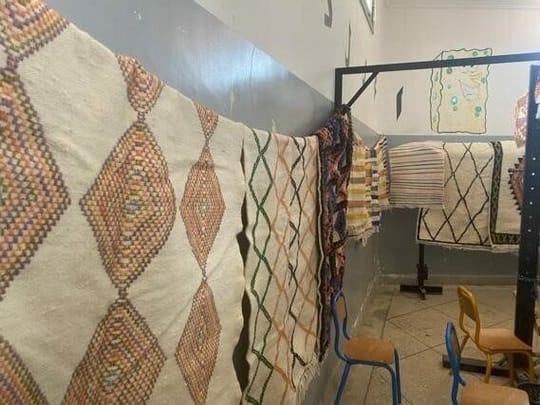Behind every handmade rug, there is a story. Tucked away in a rural community of the Tamaslohte commune in Akrich, a mere 30-minute drive from the center of Marrakech, is a cooperative of women from the اشبارو (Achbarou) village. These women have been making rugs for generations. Rugs are made to memorialize emotions, stories, and love. When the women see the rugs, they remember something of the past. Moroccan women make rugs to pass on to their families. When their sons or daughters marry, a rug is made for them to signify the new stage in their lives. Behind the design of the rugs, there is a message. Every shape and every design has a meaning. When a woman’s daughter is pregnant, the mother begins a rug and works on it throughout the whole nine months. The final string is added at the exact moment of birth, signaling the moment when the new life is brought into the world. The women in the Achbarou Cooperative, through the help of the High Atlas Foundation (HAF), the Empowerment Institute, and the US Embassy, have been able to transform this tradition into an economic activity that helps them cover their household expenses.
The twenty-two women working at the Achbarou Cooperative first participated in the HAF’s IMAGINE workshop. They benefited from the participatory approach and their empowerment. For the first time, they were asked about their desires and goals for their lives, and then were told that these goals were possible. Inspired by the empowerment workshop, these women took something with immense cultural and traditional importance and turned it into a successful business. The women of Achbarou village, as a part of the project for Bolstering Women’s Development in Rural Morocco, handmake the rugs through every step of the process. Beginning with wool from local sheep, they produce yarn and string. This is dyed with local plants and herbs and hung outside to dry in the cooperative’s courtyard. The yarn is then strung across massive looms and the women begin the process of weaving the rugs. As the women only have time to work in between caring for their home and their family, these rugs can sometimes take years to complete. They are a labor of love.
When I walked into the display and work room, I was struck by the beautifully intricate designs covering the walls. There were rugs of all sizes, colors, and patterns. Half-finished rugs stood attached to the wooden loom. I was looking at thousands of hours of work. The women primarily sell these rugs to the High Atlas Foundation, but they are working towards expanding their clientele. Staff and volunteers buy these rugs for personal use, but many of these rugs also adorn the floors of the office work spaces and prayer room. One can buy a rug for $15 to $50, depending on the size and design, a price that does not nearly reflect the amount of time and effort put into each creation. The women are then able to use this money to help pay for the expenses of food, clothing, and utilities. In the spirit of Moroccan hospitality, the women invited us to tea and bread before we left their cooperative.
The Achbarou Cooperative is only one of the eleven women’s cooperatives that the HAF has helped to create. It is also not the last, as HAF has facilitated sixty IMAGINE Workshops thus far, benefitting 1,242 people in 19 provinces, and more are completed each year. Women make up 97% of these participants. They approach these workshops with a desire to learn and to grow, and HAF does everything it can to fulfill this desire. A major part of development is empowering women to embrace their potential within the workforce. Women from all over rural Morocco have been inspired to start cooperatives based on their passions, whether those may be cookies, salty snacks, quinoa, Argan or olive oil, clothing, rugs, or fruit trees from a nursery. There is so much that can be learned from each of these cooperatives, and I am forever grateful that I had the opportunity to experience the tradition of the اشبارو rugs.
